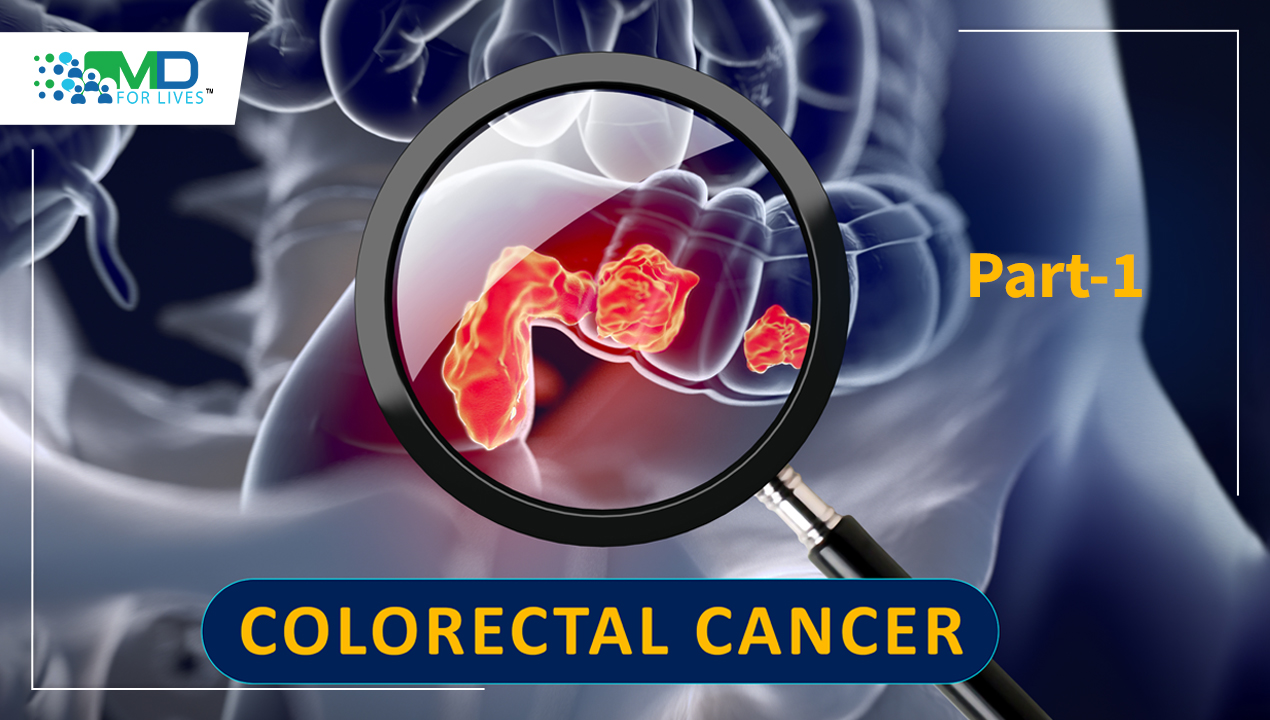Colon cancer, rectal cancer, colorectal cancer, bowel cancer; the name changes depending on where the malignancy originates, but diagnosis, genetics, and management have become more uniform and standardized.
Much about colorectal cancer genetics is still to be discovered. We know that 100% of patients with hereditary mutations of the APC gene develop colon cancer by 40 years of age. We know HNPCC (hereditary nonpolyposis colon cancer syndrome, also known as Lynch syndrome) has a 40% risk of colorectal cancer, as well as an increased risk of developing urothelial cancer, endometrial cancer, or other cancers.
We know deficient mismatch repair (dMMR) due to inherited mutation in one of the mismatch repair genes, such as hMLH1, hMSH2, hMSH6, hPMS1, hPMS2, and possibly other undiscovered genes is highly prevalent in colon cancer (particularly Lynch syndrome).
We think low fiber diets, high red meat, animal fat (Tabung et al.) and low fruit/vegetable intake increase the risk of colorectal cancer (a study by Aune et al. found high fiber diets, like cereal fiber and whole grains, reduced risk of this type of cancer; while a study by Pala et al. argued that yogurt intake also decreased risk of the disease).
Risk is high in overweight men, yet also in lean women (Jacobs et al.), with WNT-CTNNB1 signaling an important element in that. Men or women who drink alcohol (Cho et al.) and patients with a history of inflammatory diseases (Chron’s disease, ulcerative colitis) are also associated with high risk.
Epidemiology:
Rates of colorectal cancer and rates of mortality have actually gone down for many decades. From 2007 to 2016, the incidence decreased by 2.4% annually. Still, colorectal cancers are the third most common cancer, and third most likely to cause death, with estimated rates of 106,180 new cases by 2022 (American Cancer Society) and estimated deaths of 52,580 over the year.
Racially, the rates of colorectal cancer are 47% higher in black men and 34% higher in black women compared to white people, though death rates from 2007 to 2016 were more apparent in the white community.
Colorectal cancer is mostly equal between men and women (ACS predicts 54,040 men and 52,140 women through 2022 in the USA).
The median age at diagnosis is 67 years, with 10 to 20 years as the predicted rate of malignancy from early pre-malignancy. However, over the last 30 years, colon cancer in adults aged 29 to 30 has increased by 1.0% to 2.4%. Adults who were born around 1950 have now doubled the risk of developing colon cancer, with obesity cited as a big reason.
Prognosis:
In the USA, the 5-year survival rate of colorectal cancer is 64.6%.
There is a 90.2% 5-year survival rate for localized disease, 71.8% for regional disease, and 14.3% for distant disease.
Chua et al. found that 1 in 3 patients who had resection for colorectal liver metastases survived beyond 5 years, with half of those surviving beyond 10 years.
There are now a number of key factors that predict worse outcomes for colorectal cancer patients:
- If the size is greater than 5 cm,
- If there is a disease-free interval of less than a year.
- If there is more than one tumor
- If the primary lymph node is positive for cancer
- If the carcinoembryonic antigen (CEA) level is greater than 200 ng/mL (Aggarwal et al).
- If a patient has a high number of T-regulatory cells relative to CD4/CD8 (Katz et al).
- Patients with pre-existing mental disorders.
- Patients that have not had aspirin – a well-known ameliorator of colon cancer (Rothwell et al.; Burn et al.)
- Patients that have not had surgery, chemotherapy, or radiation therapy.
- Patients who smoke (especially those with microsatellite instability high (MSI-H) (Phipps et al.)
- Patients with diabetes mellitus or cardiovascular disease risks (Dehal et al.).
Patient History:
Common presentations include:
- Abdominal pain
- Iron-deficiency anemia
- Rectal bleeding
- Change in bowel habits
- Intestinal obstruction/perforation
Right-sided lesions (associated with younger age) have the following common symptoms:
- Bleeding
- Diarrhea
Left-sided tumors (associated with older age) have the following major symptom:
- Bowel obstruction
Physical Examination:
There are a number of non-specific findings, like fatigue or weight loss, though when the disease advances, you may find the following findings:
- Macroscopic rectal bleeding
- Palpable abdominal mass
- Abdominal tenderness
- Hepatomegaly
- Ascites
Differential Diagnoses:
Care must be made to ensure you are treating colon cancer, and not similar diseases, for example:
- Carcinoid/neuroendocrine tumors and rare tumors of the GI tract
- Ischemic bowel
- GI lymphoma
- Small intestine carcinoma
- Arteriovenous malformation (AVM)
Particular emphasis must be made to distinguish between colon cancer and
- Chron’s disease
- Ileus
- Small intestinal diverticulosis
- Ulcerative colitis
Workup
A large reason for lower rates of colorectal cancer is because of new and earlier screening methods; this includes colonoscopies every 10 years (starting from age 50) and a biopsy for any suspicious lesions. For patients under 70, those who have tested positive for colorectal cancer should also be assessed for hereditary nonpolyposis colon cancer syndrome (HNPCC, Lynch syndrome). In 2016, the FDA approved Epi proColon, a qualitative in-vitro assay for detecting methylated Septin9 DNA, which is indicative of colorectal cancer.
After the biopsy, lab studies should be utilized to assess liver/kidney functions and assess tumor burden. Imaging is used to stage cancer (ideally pre-surgery).
The following tests should be conducted:
- Complete blood count
- Serum chemistries
- Liver function
- Renal function
- Serum carcinoembryonic antigen (CEA) level (high levels indicate advanced disseminated disease)
- Imaging: abdominal/pelvic CT and MRI, contrast ultrasound of the abdomen/liver (optional: chest radiograph, chest CT scan, abdominal barium study to delineate primary lesion before surgery). PET-CT scans have become a new imaging modality allowing for the detection of metastatic deposits and are especially useful to detect mucinous signet-ring cell variants of colorectal cancer.
- Tests to detect adenomatous polyps and cancer include flexible sigmoidoscopy (every 5 years), colonoscopy (every 10 years), double contrast barium enema (every 5 years), and CT colonography (every 5 years).
- Tests to detect the frequency of cancer include a guaiac-based fecal occult blood test (every year), fecal immunochemical test (FIT), and stool DNA test.
- Post-polypectomy surveillance (regularity varies depending on the number of adenomas, presence of serrated polyps, hyperplastic polyps, or if the patient has additional dysplasia).
- Molecular testing: including:
a) RAS mutations (KRAS, NRAS codons 12/13 of exon2, 59/61 of exon 3, 117/146 of exon 4). KRAS mutations are present in 40% of colon adenocarcinomas and affect biological agents targeting EGFR
b) BRAFV600 with dMMR/MSI-H testing.
c) Loss of MLH1
d) Formalin-fixed, paraffin-embedded tissue is an acceptable specimen.
- TNM scoring system is used for anatomic stage and prognostic groups
Prognostic factors that are associated with a worse prognosis include ulcerative growth pattern, perforation, elevated CEA, and bowel obstruction at diagnosis. While p53, loss of heterozygosity for 18q, EGFR gene amplification, and mutations of deletion in colon cancer gene (DCC).
In part 2, we will go over treatment pathways

MDForLives is a vibrant community of healthcare professionals and patients dedicated to shaping the future of healthcare. We provide valuable global insights to healthcare companies through online surveys, interviews, and discussion forums.





